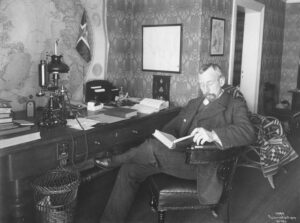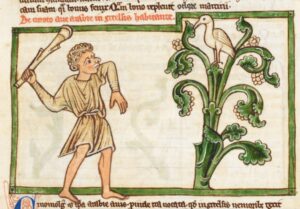Born in 1859, English engineer and mountaineer Oscar Eckenstein was a force in late 19th-century climbing. He was a pioneer of bouldering, improved the ice ax, and designed the modern crampon. Eccentric and unpredictable, he led the first serious expedition to K2.
One of the great multi-talented Victorians, Eckenstein grew up excelling in mathematics, science, woodwork, music, and sports. By the late 1800s, Eckenstein had a career as a railway engineer, but his real passion was mountaineering. He had been climbing since his early teens. In 1872, at the age of 13, he summited his first peak. Not a big deal nowadays, but at that time, almost unprecedented.
Over the next few years, Eckenstein climbed in England and Wales, the Alps, Himalaya, and even across the ocean to Mexico. In 1887, he made a first ascent of Stecknadelhorn; then almost 20 years later, he did an FA of Mont Brouillard. But it was his 1902 attempt on K2 for which he is best known.
Personality
Declaring himself a proud socialist, Eckenstein was anti-establishment. He expressed his great dislike for the elite Alpine Club, which rejected him for his outlandish notions or more likely, his Semitic heritage. Rather than trying to fit in, Eckenstein made a point to stand out. He was not prim and proper like his peers. Rather, he looked unkempt with a crazy beard and old clothing.
Eckenstein was a difficult man. Many accounts from expedition team members and close friends described him as generally unpleasant, easily worked up, and quick to judge. He had a famous falling out with Alpine Club regular Sir Martin Conway. Conway even accused Eckenstein of trying to poison him at one point, but this was never confirmed. Because of the friction, Eckenstein had to leave an 1892 expedition to Baltoro Muztagh.

K2 expedition team in 1902. Eckenstein is in the middle row, squatting at left. His even more eccentric and bedraggled companion, Aleister Crowley, is beside him. Photo: Hulton Archive
He had a few close friendships in his life. His good friend Aleister Crowley took pleasure at boasting that he was “the wickedest man in England”. But Crowley was an exceptional climber, in part because of his tolerance for risk. He was also an occultist who tried to create his own religion. He and Eckenstein often butted heads over Crowley’s interest in magic, but the friendship remained intact.
Eckenstein was also very daring and ahead of his time. He championed free climbing and bouldering, practices mostly unheard of at the time. He also promoted climbing without paid guides. Sources say he hosted the first-ever bouldering contests in the Himalaya.
Despite his daring climbing, one particularly odd trait was his fear and hatred of kittens.
Innovations
Eckenstein gained notoriety for his innovations, particularly his groundbreaking 1908 creation of a 10-point crampon, which improved techniques and safety in ice climbing. Throughout the 19th century, climbers did not like wearing crampons, preferring to cut steps into the ice.
Eckenstein found this archaic and impractical, choosing to resurrect and rework the crampon. With the help of Italian blacksmith Henry Grivel, the pair created a crampon that was more secure and able to withstand a great amount of weight. The only drawback was its one-kilo weight.
Eckenstein also put his engineering skills to use by designing a new ice ax with a shorter 85cm shaft, compared to the usual 120cm one. The blade was 18cm. Unfortunately, these inventions took several decades to catch on because of his exclusion from the almighty Alpine Club.

Oscar Eckenstein in the 1890s. Photo: Abraham Brothers
Eckenstein stressed the importance of balance in climbing, which he thought climbers overlooked. His experience with gymnastics influenced his climbing style. He promoted the use of smaller holds and proper positioning of the fingers to balance, rather than relying on larger hand and foot holds. These simple adjustments did not catch on as fast either. Crowley described him as strong enough to pull himself up by his fingers and his style as “clean, orderly, and intelligible”.
Notable expeditions
In 1886, he climbed the Hohberghorn, Galenhorn, and Klein Dürrenhorn with August Lorria. In 1887, he made the first ascent of Stecknadelhorn and Nadeljoch. He and a few others also ascended the Dom, the North Ridge of Mont Brouillard, and the Matterhorn.
He did not focus on racking up firsts or exploring new regions. He used these expeditions to perfect his techniques, note the limitations of current equipment, and seek inspiration to invent new ones. An article in the Alpine Journal described him as a “scientific mountaineer”.
However, the 1902 expedition to K2 was a dramatic first expedition to the world’s second-tallest mountain. In India, British authorities detained Eckenstein as a suspected spy. Even though he walked free some weeks later, he and Crowley accused their rival, Sir Martin Conway, of orchestrating the affair.
The team then spent two weeks traveling to K2. Unfortunately, the expedition fell through after five unsuccessful attempts. Problems included illness, personal grievances, dangerous weather, and insufficient equipment.

In Eckenstein’s day, crampons were an innovative idea, not standard gear on ice. Photo: africa_pink/Shutterstock
Legacy
Circumstances did not allow his contributions and brilliance to receive their due recognition. He became the embodiment of a post-Victorian world, breaking those last barriers of mountaineering elitism.
His legacy still permeates the climbing world today. Although he wasn’t a people person, he was devoted to helping climbing progress. His love of and contributions to bouldering led to a Snowdonian boulder called the Eckenstein Boulder to be named in his honor.
In 1921, he died from tuberculosis, leaving behind his wife Margery but no children.






